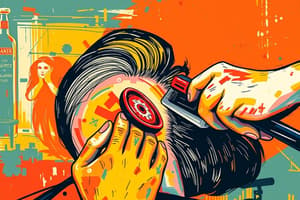Podcast
Questions and Answers
What is the primary physiological role of the voiding center in the body?
What is the primary physiological role of the voiding center in the body?
- To prevent contraction of the detrusor muscle (correct)
- To enhance urethral pressure during micturition
- To maintain low intra-vesical pressure
- To facilitate voluntary bladder contractions
Which type of incontinence is most commonly associated with involuntary bladder contractions?
Which type of incontinence is most commonly associated with involuntary bladder contractions?
- Overflow incontinence
- Stress urinary incontinence
- Total urinary incontinence
- Overactive bladder (correct)
What factor contributes to urinary incontinence in aging individuals?
What factor contributes to urinary incontinence in aging individuals?
- Increased bladder capacity
- Reduced incidence of nocturia
- Decreased bladder contractility (correct)
- Higher urethral pressure
Which underlying condition can lead to stress urinary incontinence in women?
Which underlying condition can lead to stress urinary incontinence in women?
Which option describes a scenario related to overflow incontinence?
Which option describes a scenario related to overflow incontinence?
Which of the following is NOT a recognized cause of incontinence?
Which of the following is NOT a recognized cause of incontinence?
During the filling phase of the bladder, what is the state of the bladder's outflow?
During the filling phase of the bladder, what is the state of the bladder's outflow?
What describes the change in bladder response often observed in aging individuals?
What describes the change in bladder response often observed in aging individuals?
What characterizes urge incontinence?
What characterizes urge incontinence?
Flashcards
Incontinence
Incontinence
The involuntary loss of urine.
Voiding Physiology
Voiding Physiology
The process of emptying the bladder; involves two phases: the filling/storage phase (sympathetic) and voiding/emptying phase (parasympathetic).
Urge Incontinence
Urge Incontinence
Sudden, strong urge to urinate followed by involuntary loss of urine, often caused by an overactive bladder.
Stress Incontinence
Stress Incontinence
Signup and view all the flashcards
Overactive Bladder
Overactive Bladder
Signup and view all the flashcards
Neurological Diseases
Neurological Diseases
Signup and view all the flashcards
Aging Effect on Incontinence
Aging Effect on Incontinence
Signup and view all the flashcards
BPH (Benign Prostatic Hyperplasia)
BPH (Benign Prostatic Hyperplasia)
Signup and view all the flashcards
UTI (Urinary Tract Infection)
UTI (Urinary Tract Infection)
Signup and view all the flashcards
Mixed Incontinence
Mixed Incontinence
Signup and view all the flashcards
Study Notes
Male and Female Incontinence
- Incontinence is the inability to control urination at the appropriate time and place
- Involuntary urine loss
- Prevalence in elderly population: 35% (more than 20% in men, 55% in women)
- Incontinence negatively impacts quality of life, causing psychological distress, social isolation, and depression
Voiding Physiology
- Filling phase (Sympathetic nervous system): Intra-vesical pressure is low, bladder outflow is closed, no involuntary bladder contractions
- Voiding phase (Parasympathetic nervous system): Detrusor muscle contracts, sphincters relax
Voiding Physiology (cont.)
- Voiding center: Prevents detrusor muscle contraction until micturation is desired
- Aging: Increases frequency of involuntary bladder contractions; bladder capacity reduces; urethral pressure decreases; bladder contractility decreases; nocturia incidence increases; BPH in men, menopausal estrogen reduction
Urodynamics
- Bladder pressure increases with consequences
- Detrusor pressure is not affected by abdominal pressure
Causes of Incontinence
- Aging
- Urinary tract infections (UTIs)
- Neurological diseases
- Benign prostatic hyperplasia (BPH)
- Menopause
- Diabetes
- Surgery
- Overactive bladder
- Constipation
Incontinence Types
- Urge incontinence: Sudden strong urge to urinate, overactive bladder, involuntary contractions, neurogenic bladder, or infection
- Stress urinary incontinence: Incontinence with intra-abdominal pressure increase (coughing, laughing, sneezing), weakening of pelvic floor muscles, weak pelvic floor, intrinsic sphincter failure
- Mixed incontinence: Stress and urge incontinence (dominance undetermined)
- Total incontinence: Severe incontinence; outflow obstruction, BPH, tumor, stricture, neurological issues, spinal cord lesions, pelvic surgery, or other pharmaceutical or medical issues
- Overflow incontinence: Incontinence following retention, blockage, or other issues
Anatomy
- Prostate - Male anatomy, part of the urinary tract
Evaluation
- Symptoms and quality of life assessment
- Incontinence type and possible causes
- History (duration, UTI, stones, previous urinary surgery, diabetes, constipation)
- Non-pharmacological substances
- Neurological assessment (BPH, pregnancy)
- Relationship between symptom onset and delivery
- Menopause
- Physical examination (genitalia and neurological exam, anal tonus, bulbocavernous reflex, stress test)
- Laboratory tests
- Imaging studies
- Urodynamic studies
Treatment
- Behavioral modality: Lifestyle changes (coffee & water restriction, weight loss), double timed voiding, pelvic floor exercises (Kegels), and biofeedback
- Pharmacological treatment: Antimuscarinics (anticholinergics), Mirabegron, Tricyclic antidepressants (imipramine), estrogen
- Surgical treatment: Transobturator tape, tension-free tape or sling procedures.
Studying That Suits You
Use AI to generate personalized quizzes and flashcards to suit your learning preferences.




